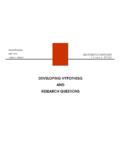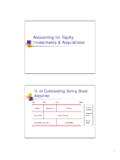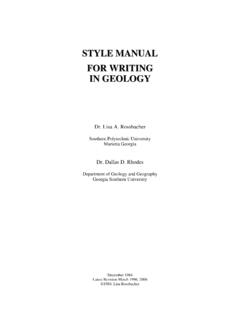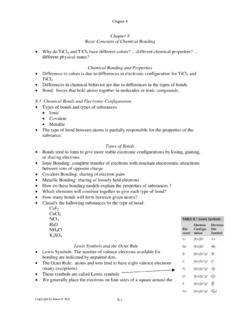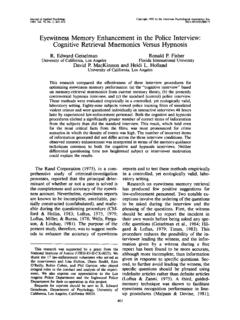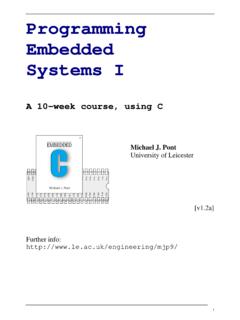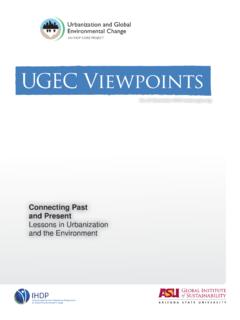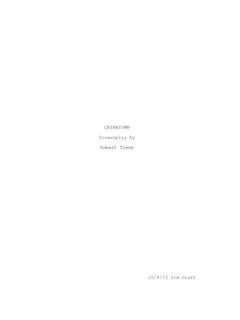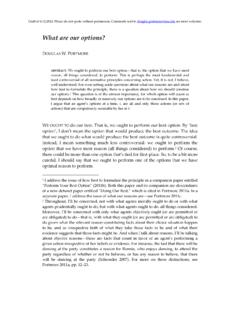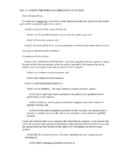Transcription of EXPERIMENTATION A RESEARCH METHODOLOGY
1 EXPERIMENTATIONA RESEARCH METHODOLOGYPRESENTED BY Ms. MallikaRaoAND Ms. ShwetaShahANP/DSC 500 RESEARCH Methods in Architecture Fall 2002 Fall 2002 Ms. Mallika Rao & Ms. Shweta ShahANP / DSC 500 WHAT IS AN EXPERIMENTAL RESEARCH DESIGN ?WHAT IS AN EXPERIMENTAL RESEARCH DESIGN ? The purpose of experimental RESEARCH design is to enable the researcher to credibly establish a cause-effect relationship Many studies illustrate how experimental method is used to separate alternative explanations and test them The special nature of the experiment is that they are always conducted under controlled conditions in a systematic way in which an artificial situation is created and events which generally go together are pulled apartFall 2002 Ms. Mallika Rao & Ms. Shweta ShahANP / DSC 500 TYPES OF EXPERIMENTSTYPES OF EXPERIMENTST here are three general categories of experiments Laboratory Experiments Field Experiments Natural ExperimentsFall 2002 Ms.
2 Mallika Rao & Ms. Shweta ShahANP / DSC 500 TYPES OF EXPERIMENTSTYPES OF EXPERIMENTS Laboratory Experiments -most common carried out in a specially created setting-experimenter able to control wide variety of extraneous variables Field Experiments -researcher manipulates the independent variables but does so ina field outside environment where only the setting differs Natural Experiments termed as Quasi -Experiments-are studies which take advantage of experiment like situations that arise as a result of social policy or events in variable not directly under the control of the investigator-subjects are neither randomly assigned nor matched in groupsFall 2002 Ms. Mallika Rao & Ms. Shweta ShahANP / DSC 500 COMPONENTS OF AN EXPERIMENTAL METHOD PLANCOMPONENTS OF AN EXPERIMENTAL METHOD PLAN Participants Elements and factors Setting Instruments and materials Procedures and measures Statistical analysis ExperimenterFall 2002 Ms.
3 Mallika Rao & Ms. Shweta ShahANP / DSC 500 PARTICIPANTS-SELECTIONPARTICIPANTS-SELEC TION Random selection or random sampling-With this each individual has an equal probability of being selected from the population, ensuring that the sample will be representative of the population.(Keppel, 1990) Non-random selection or convenient sampling-Use of naturally formed groups for practical or ethical 2002 Ms. Mallika Rao & Ms. Shweta ShahANP / DSC 500 PARTICIPANTS-ASSIGNMENTPARTICIPANTS-ASSI GNMENT If random assignment is made,indicate how it is made. Identify other controls in the experimental design that will systematically control the variables that might influence the of covariates and statistical control-Use of subgroupsFall 2002 Ms. Mallika Rao & Ms. Shweta ShahANP / DSC 500 PARTICIPANTS-NUMBERPARTICIPANTS-NUMBER Number of participants in each group.
4 Systematic procedures for determining the size of each group. Power analysis (Lispey, 1990) to identify the appropriate sample size for of statistical significance-Amount of power desired-The effect sizeFall 2002 Ms. Mallika Rao & Ms. Shweta ShahANP / DSC 500 PARTICIPANTS SUBJECT CHARACTERISTICSPARTICIPANTS SUBJECT CHARACTERISTICSV alidity threats - Qualities of the subject are likely to influence the experimental outcome age, education Participants expectations and beliefs about the experiment also influence the resultsSolutions Eliminate /reduce extraneous variables Make the extraneous variables as similar as possible for all treatment conditions in matched groups as well as in random assignmentFall 2002 Ms. Mallika Rao & Ms. Shweta ShahANP / DSC 500 VARIABLESVARIABLESV ariables -Elements and factors under consideration Any characteristic or quality which differs in degree or kind and can be measured Have values or levels of measure.
5 For eg. Height, running speed, age 2002 Ms. Mallika Rao & Ms. Shweta ShahANP / DSC 500 VARIABLES VARIOUS TYPES VARIABLES VARIOUS TYPES Continuous variables Categorical variables Combination of both Dependent variables Independent variables Extraneous variablesAll are associated with the subjects, the experimenter, the settings and the experimental procedure itselfFall 2002 Ms. Mallika Rao & Ms. Shweta ShahANP / DSC 500 SETTING CHARACTERISTICSSETTING CHARACTERISTICSV alidity threats Qualities of the setting in which the experiment takes place -functioning of the equipment, time of the day and all other situational variables are potential sources of errorsSolutions Run all subjects about the same time of the day Keep the Lab conditions as similar as possible for all subjects Check equipment frequently to make sure that it is functioning properlyFall 2002 Ms.
6 Mallika Rao & Ms. Shweta ShahANP / DSC 500 INSTRUMENTS AND MATERIALSINSTRUMENTS AND MATERIALS Choice Development Items Scales Reports of reliability Validity of scores on past uses Any permissions needed to use them Pilot test of materialsFall 2002 Ms. Mallika Rao & Ms. Shweta ShahANP / DSC 500 IMPORTANT TERMINOLOGYIMPORTANT TERMINOLOGY Experimental group-A subject group exposed to the independent called the treatment group Control group-A subject group which resembles the experimental group in every way except that it is not exposed to the independent 2002 Ms. Mallika Rao & Ms. Shweta ShahANP / DSC 500 PROCEDURES AND MEASURESPROCEDURES AND MEASURES Indication of overall experiment type Citing reasons for the design Advancing a visual model for understanding of proceduresFall 2002 Ms. Mallika Rao & Ms. Shweta ShahANP / DSC 500 TYPES OF EXPERIMENTAL DESIGNTYPES OF EXPERIMENTAL DESIGN Pre-experimental design X---------O True experimentsGroup A: R-----O------X-------OGroup B: R------O---------------O Quasi experiments Group A: O------X-------OGroup B: O---------------OX: exposure of a group to an experimental variableO: observation or measurement recorded on an instrumentR: random assignmentFall 2002 Ms.
7 Mallika Rao & Ms. Shweta ShahANP / DSC 500 STATISTICAL ANALYSISSTATISTICAL ANALYSIS Descriptive statistics calculated for observations and measures at the stages of the experiment Means, standard deviations and ranges Inferential statistical tests used to examine the hypotheses in the studyFall 2002 Ms. Mallika Rao & Ms. Shweta ShahANP / DSC 500 EXPERIMENTER CHARACTERISTICSEXPERIMENTER CHARACTERISTICSV alidity threats Like subjects, possess qualities that might influence the outcome of the experiment. For eg. Nervousness or pre-occupation with other matters Must be eliminated or kept the same for all subjectsSolutions Train experimenters in order to reduce extraneous influences Use the same experimenter for all subjects If more than one experimenter is involved, have each run an equal number of subjects Randomly assign experimenters to subjectsFall 2002 Ms.
8 Mallika Rao & Ms. Shweta ShahANP / DSC 500 LIMITATIONSLIMITATIONS Although this METHODOLOGY allows the researcher an impressive amount of control over variables , it is chiefly limited by its artificiality Conditions in the laboratory may be different from those in the real world and people may react and respond differently Some behavioral issues are not suitable for EXPERIMENTATION for ethical reasons or for cost

